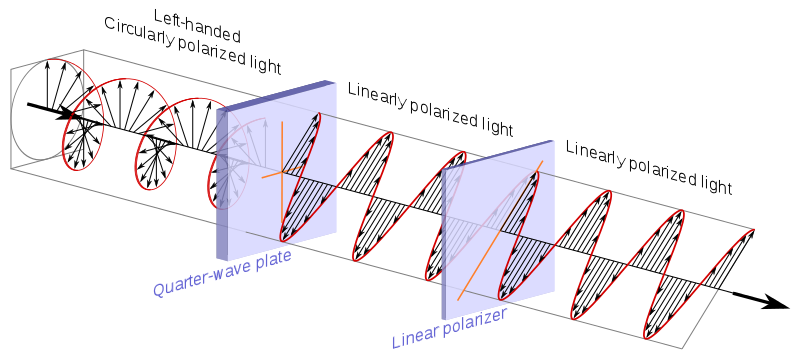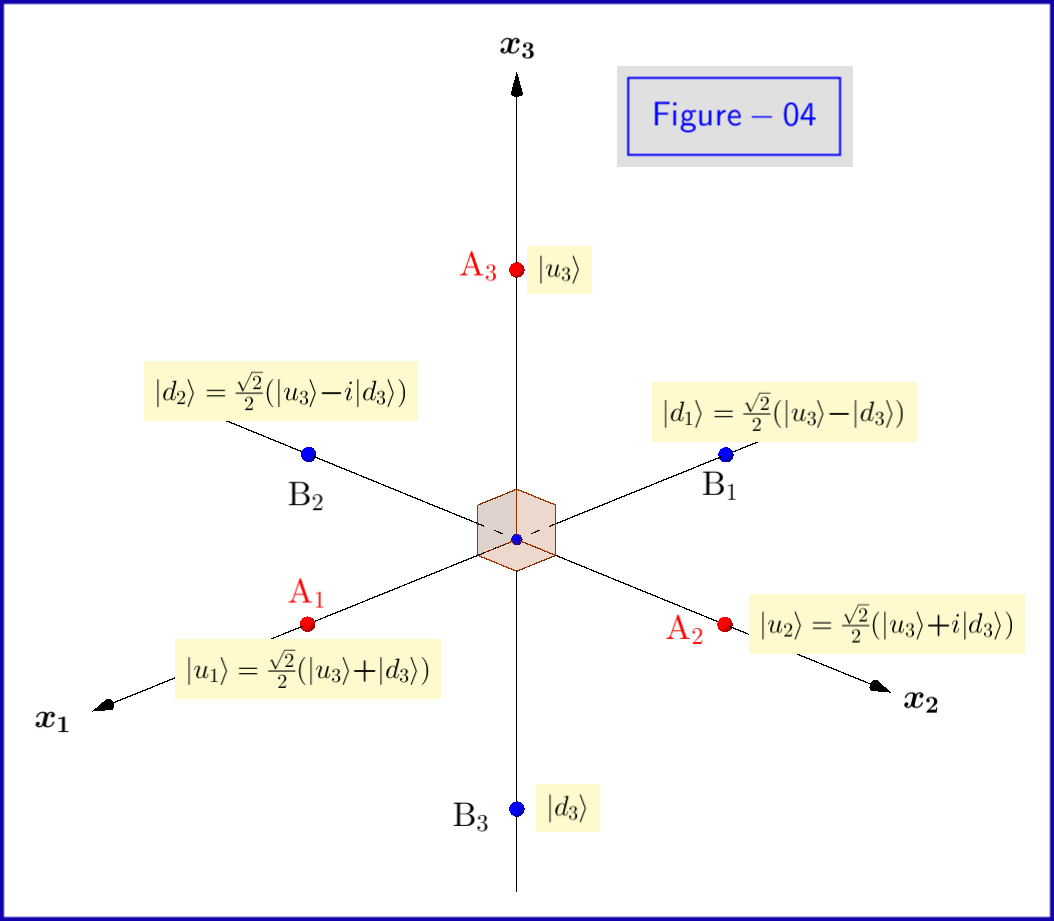Think about photon spin
Thinking about this more concrete case helped me get some useful pictures in my head. There is even a well known a more optics oriented analogue worth having in mind: the Poincaré Sphere.
Photon spin is a two-state quantum system, which as Frobenius mentions, is what the Bloch sphere models.
Photon spin is also easy to understand/visualize/manipulate experimentally.
Physical polarizer filters
First let's think about the most concrete thing possible: the polarizer filters.
There are two types of polarizer filters you could think about:
linear polarizer, at any angle between -90 and 90.
E.g. here's one at 90 degrees:

and here's one at 45 degrees:

and here's one at 0 degrees:

Source
Wikipedia describes a few ways to create such filters, and the above pictures are Polariod filters, which is used in sun glasses and photography and therefore readily available.
From a quantum mechanics point of view, the 90 and 0 degree orientations make the same measurement: the only difference is that one lets the photon pass but the other blocks it. But we can use both equally to determine the level of linear vertical polarization of the photon: you just have to take the complement the value.
And since every measurement corresponds to a Hermitian matrix, we can represent both 0 and 90 with a single matrix:
$$M_0 = \begin{bmatrix}
1 & 0 \\
0 & -1 \\
\end{bmatrix}
$$
And the matrix for 45 degrees is:
$$M_+ = \begin{bmatrix}
0 & 1 \\
1 & 0 \\
\end{bmatrix}
$$
circular polarizer, which as Wikipedia explains is usually made with a quarter wave plate + a linear polarizer:

Source.
Its corresponding matrix is:
$$M_i = \begin{bmatrix}
0 & -i \\
i & 0 \\
\end{bmatrix}
$$
The above matrices are the so called Pauli matrices.
Some interesting state vectors
Now let's give names to 6 poles representing 6 possible interesting photon states on the Bloch sphere, and try to understand how they interact with the filters.

Source.
$$
\begin{alignat*}{4}
&\vert 0\rangle &&= &&\begin{bmatrix}1\\0\end{bmatrix} &&= \text{linear 90°} \\
&\vert 1\rangle &&= &&\begin{bmatrix}0\\1\end{bmatrix} &&= \text{linear 0°} \\
&\vert +\rangle &&= \frac{1}{\sqrt{2}} &&\begin{bmatrix}1\\1\end{bmatrix} &&= \text{linear 45°} \\
&\vert -\rangle &&= \frac{1}{\sqrt{2}} &&\begin{bmatrix}1\\-1\end{bmatrix} &&= \text{linear -45°} \\
&\vert i\rangle &&= \frac{1}{\sqrt{2}} &&\begin{bmatrix}1\\i\end{bmatrix} &&= \text{circular clockwise} \\
&\vert -i\rangle &&= \frac{1}{\sqrt{2}} &&\begin{bmatrix}1\\-i\end{bmatrix} &&= \text{circular counter-clockwise} \\
\end{alignat*}
$$
The first thing we notice is that the following pairs are all bases:
- $\vert 0\rangle$ and $\vert 1\rangle$
- $\vert +\rangle$ and $\vert -\rangle$
- $\vert i\rangle$ and $\vert -i\rangle$
For example, we could represent:
$$
\begin{alignat*}{3}
&\vert 0\rangle &&= \frac{1}{\sqrt{2}}(\vert +\rangle &&+ \vert -\rangle) \\
&\vert 1\rangle &&= \frac{1}{\sqrt{2}}(\vert +\rangle &&- \vert -\rangle) \\
&\vert 0\rangle &&= \frac{1}{\sqrt{2}}(\vert i\rangle &&-i \vert -i\rangle) \\
&\vert 1\rangle &&= \frac{1}{\sqrt{2}}(-i\vert i\rangle &&+ i\vert -i\rangle)
\end{alignat*}
$$
And then, we also observe that:
- $\vert 0\rangle$ and $\vert 1\rangle$ are eigenvectors of $M_0$
- $\vert +\rangle$ and $\vert -\rangle$ are eigenvectors of $M_+$
- $\vert i\rangle$ and $\vert -i\rangle$ are eigenvectors of $M_i$
If we remember that the result of a measurement in quantum mechanics is the eigenvector of an eigenvalue, with probability proportional to the projection, we get the following sample probabilities for these experiments:
- $\vert 0\rangle$ state on:
linear polarizer 90°: 100% pass
linear polarizer 0°: 0% pass
linear polarizer 45°: 45% pass, because:
$$\vert 0\rangle = \frac{1}{\sqrt{2}}(\vert +\rangle + \vert -\rangle)$$
linear polarizer -45°: 45% pass
circular polarizers: 45% pass. This is because a linear state 0 can be decomposed into two circular polarizations:
$$
\vert 1\rangle = \frac{1}{\sqrt{2}}(-i\vert i\rangle +i \vert -i\rangle)
$$
- $\vert 1\rangle$:
- linear 90°: 0% pass
- linear 0°: 100% pass
- linear 45°: 45% pass
- linear -45°: 45% pass
- circular: 45% pass
- $\vert +\rangle$:
- linear 90°: 45% pass
- linear 0°: 45% pass
- linear 45°: 100% pass
- linear -45°: 0% pass
- circular polarizers: 45% pass
- $\vert i\rangle$:
- linear 90°: 45% pass
- linear 0°: 45% pass
- linear 45°: 45% pass
- linear -45°: 45% pass
- circular clockwise: 100% pass
- circular counter-clockwise: 0% pass
Relative phase
One important semiclassical intuition to remember is that:
circular polarization == two orthogonal linear polarizations 90 degrees out of phase:

Source.
So for example in:
$$
\vert i\rangle
= \frac{1}{\sqrt{2}} \begin{bmatrix}1\\0\end{bmatrix} +
\frac{i}{\sqrt{2}} \begin{bmatrix}0\\1\end{bmatrix}
= \frac{1}{\sqrt{2}} \vert 0\rangle + \frac{i}{\sqrt{2}} \vert 1\rangle
$$
we have a 90 degree relative phase because of the $i$ relative phase difference between $\vert 0\rangle$ and $\frac{i}{\sqrt{2}} \vert 1\rangle$.
But in the diagonal one, they are in-phase relative to $\vert 0\rangle$ and $\vert 1\rangle$:
$$
\vert +\rangle
= \frac{1}{\sqrt{2}} \begin{bmatrix}1\\0\end{bmatrix} +
\frac{i}{\sqrt{2}} \begin{bmatrix}0\\1\end{bmatrix}
= \frac{1}{\sqrt{2}} \vert 0\rangle + \frac{1}{\sqrt{2}} \vert 1\rangle
$$
so the relative phase is 0 for that one.
Walk around the sphere
One common way to represent a state in the Bloch sphere is to give just the two $\theta$ and $\phi$ angles as shown below:

Source.
Since a sphere is non-Euclidean, a good way to visualize it is to walk through some easy to understand paths around it. On the following image we do two paths:
- start at 0, pass through +, 1, -, and return back to 0
- start at 0, pass through i, 1, -i, and return back to 0

Source.
Walking from + through i, -, -i and back to + is left as an exercise: the circle would become an oblique eclipse, and thins downs more and more into a 45 degree line.
This leads to a clear interpretation of the angles:
- $\theta$: the larger it is, the more likely $\vert 1\rangle$ becomes compared to $\vert 0\rangle$
- $\phi$: the relative phase between $\vert 0\rangle$ and $\vert 1\rangle$. This relative phase cannot be detected by a vertical or horizontal polarizer
How can we go down from 4 real numbers to just 2 in the state?
On the Bloch sphere, we can represent state with only 2 real parameters: the angles $\theta$ and $\phi$
But in the more explicit full full state vectors, there appear to be 2 complex numbers, and therefore 4 real numbers:
$$
\begin{alignat*}{4}
&\begin{bmatrix}a + ib\\c + id\end{bmatrix} \\
\end{alignat*}
$$
Why one of the numbers must be removed is easy: the total probability has to be 1, and so:
$$a^2 + b^2 + c^2 + d^2 = 1$$
so at that point we are already restricted to a 3-sphere.
The second one is more interesting: we can remove another parameter because the global phase of the state cannot be detected by any experiments and so we are free to choose it arbitrarily.
A global phase $\phi$ is a complex number. The modulus of that number must be 1 to maintain the total probability. Because of this, a natural way to write a global phase is as:
&&e^{i\phi}$$
which automatically satisfies the above property, but sill allows for any possible value.
Experiments cannot detect global phase shifts because the outcomes of measuring:
$$k_0 \vert 0\rangle + k_1 \vert 0\rangle$$
on any of the filters is the same as that of measuring:
$$\text{phase} \times k_0 \vert 0\rangle + \text{phase} \times k_1 \vert 0\rangle$$
because $|\text{phase}| = 1$.
A natural choice is therefore to pick a global phase that rotates the state such that the multiplier of $\vert 0\rangle$ becomes a real number, i.e. setting $b = 0$.
So for example, by multiplying by an imaginary number, we could map more general states into more restricted ones such as
$$
\begin{alignat*}{2}
&\begin{bmatrix}i\\0\end{bmatrix}
&&\times -i
&&= \begin{bmatrix}1\\0\end{bmatrix}
&&= \vert 0\rangle
\\
&\begin{bmatrix}-i\\0\end{bmatrix}
&&\times i
&&= \begin{bmatrix}1\\0\end{bmatrix}
&&= \vert 0\rangle
\\
&\begin{bmatrix}-1\\0\end{bmatrix}
&&\times -1
&&= \begin{bmatrix}1\\0\end{bmatrix}
&&= \vert 0\rangle
\\
&\frac{1}{\sqrt{2}}\begin{bmatrix}i\\i\end{bmatrix}
&&\times -i
&&= \frac{1}{\sqrt{2}}\begin{bmatrix}1\\1\end{bmatrix}
&&= \vert +\rangle
\\
\end{alignat*}
$$
Why are there exactly three Pauli matrices?
I think there are deep and clear mathematical reasons that explain this, linked to them being a basis of the 2x2 Hermitian matrix space as mentioned at: https://physics.stackexchange.com/a/415228/31891 and https://en.wikipedia.org/wiki/Bloch_sphere#Pure_states and it is the crux of the question of why the Bloch sphere is used, but I haven't fully grasped it.
But in more practical terms: the three measurement devices we described are the only three possibilities (up to global rotations) such that after you pass through one, you lose all information about the other two (50% probability on the other two experiments).
Therefore they are orthogonal in a certain sense, and maximal as there is no other experiment that we could add to that set of experiments such that this property holds.
Play with Quirk
https://algassert.com/quirk
This is another worthwhile suggestion. Click those images until it all makes sense.
Other physical systems
Basically every type of quantum computer provides a physical example of what physical things look like on a Bloch sphere. It would be good to understand the different types in more detail.
Most of them appear to be state 0 on the state of lowest energy, 1 on the first energy level, and anything on the equator is a superposition. TODO physical interpretation/control of phase.













